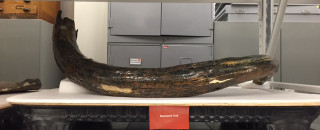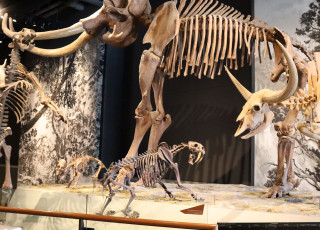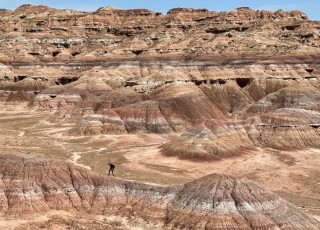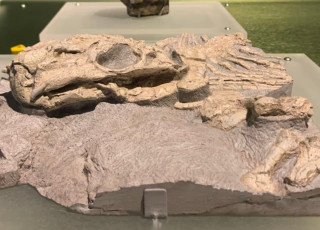Collections Manager Tip #389: Don’t Shellac the Mammoth Tusk
By Michael Mozdy
It’s really not supposed to look so shiny. Mammoth fossils have a beautiful, natural matte finish, but this one’s bringing the bling.
And from what we can tell, that’s wood shellac.
“Can we remove that shellac?” asks our Paleontology Collections Manager, Carrie Levitt-Bussian. “I called around to the best fossil preparators in the country, and the answer is: no, it would cause more harm to try to remove it. It will be a shiny tusk forever.”
Long ago, folks felt that this would be a good way to hold the tusk together (and, hey, look, now it’s shiny!), but it’s not the type of adhesive or consolidant we’d use today. The state-of-the-art consolidant we use is called Paraloid B-72 (ethyl methacrylate/methyl acrylate), made of tiny plastic beads dissolved in acetone. The more beads you add, the thicker and stickier the consolidant becomes, to the point where it can be used as a glue. More importantly, if you find you’ve made a mistake in assembling or conserving a fossil, you simply have to add more acetone (or another solvent) and it comes off so you can start over.
The ability to reverse what we do if needed is an important aspect of today’s conservation work. Past generations, despite their best intentions, lacked either the technology or the knowledge to do this properly, as our shellacked tusk can attest.
We could probably try to strip the shellac off with paint thinner, but the tusk underneath is brittle and has bonded with the shellac. We don't know what the paint thinner would do to the specimen, but the fragility of fossil ivory means it is likely to crumble to dust during this process.
Michael Mozdy is a Digital Science Writer for The Natural History Museum of Utah, a part of the University of Utah in Salt Lake City. Our mission is to illuminate the natural world and the place of humans within it. In addition to housing outstanding exhibits for the public, NHMU is a research museum. Learn more.




